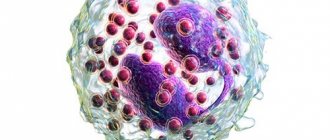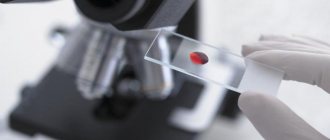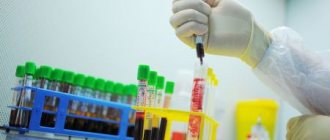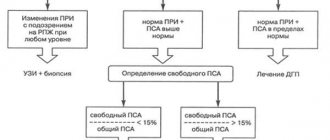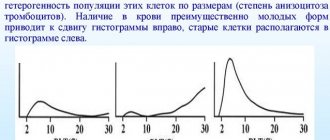Sexually transmitted diseases are becoming a horror for people, causing serious complications.
One of these diseases is syphilis. Some people are afraid of syphilis, hiding it until the last minute, pushing the disease into severe forms, thereby aggravating their further treatment.
Some try to fight it themselves, listening to the advice of friends, or reading information on the Internet. But this only complicates the situation.
RMP (microprecipitation reaction) is a blood test that helps detect syphilis.
How to identify signs of syphilis?
Syphilis can be suspected even before a blood test for bladder cancer.
Some symptoms indicate anxiety:
- The inguinal lymph nodes increase significantly in size,
- Skin rashes of a pinkish tint, especially in the thighs and shoulders,
- Formation of a genital ulcer.
Important! If you suspect the progression of sexually transmitted diseases, do not hesitate and urgently consult a qualified doctor! Based on the results of the RMP, he will determine the presence of the disease and prescribe the correct therapy.
If RMP or RPR is positive
Of course, what worries people the most is if bladder cancer is positive.
In this case, it is necessary to carry out additional confirmatory tests, as discussed above. If the subject of choice is an enzyme immunoassay and a passive hemagglutination test or RPHA, then their specificity is much higher and is 100% with a sensitivity of 95%. But even these additional methods can also give a false positive result, especially in the case of concomitant inflammatory diseases, as well as autoimmune processes. That is why in clinical practice it is necessary to confirm the diagnosis of syphilis using two additional methods. This may be an immunofluorescence or immobilization of syphilis pathogens (RIBT) reaction. But these studies are expensive and are used infrequently.
It is possible to use the complement fixation reaction (CFR), which uses a specific treponemal antigen. An immune blot is indicated, which helps in doubtful cases with an unclear clinical picture. Finally, the polymerase chain reaction comes to the rescue, with which it is possible to determine the presence of pale spirochete DNA in the patient’s body.
How does syphilis enter the body?
The bacterium can enter the body in several ways:
Sexually. More than 85% of cases of syphilis infection occur through sexual contact. Semen may contain bacteria before rashes and symptoms appear.
Also, if a rash occurs on the mucous membrane of the mouth, then the saliva is also affected by the bacteria. Therefore, even if you engage in oral sex with infected people, you are still at risk.
Through blood . The next most popular method of infection is through blood. Blood transfusions, the use of personal hygiene products (toothbrushes, razors, manicure tools), also in the event of any contact of contaminated blood with a healthy body.
Infection of a child from a sick mother.
There is a tiny chance of becoming infected through household items.
Note! Syphilis bacteria penetrate inside in any of the ways, but they always affect the body in the same way. Donate blood regularly for bladder cancer in order to avoid unpleasant treatments in the future.
When is a test ordered?
Expert opinion
Kovaleva Elena Anatolyevna
Doctor-Laboratory Assistant. 14 years of experience in clinical diagnostic services.
This is one of the simplest methods for detecting pathology, so almost everyone who is examined by gynecologists and dermatovenerologists donates blood in order to obtain a negative or positive result.
At the same time, the main task of doctors is early diagnosis and prevention of infections and epidemics. The analysis procedure is prescribed:
- those who are planning to go to hospital;
- during examination of persons deprived of liberty;
- as a preparatory stage before surgery;
- for expectant mothers to register them;
- during a planned annual preventive examination of those who most often, due to their occupation, encounter a large number of people. This category necessarily includes medical and teaching workers, sellers, cooks;
- before donating blood;
- when the first signs of the disease are detected - enlarged lymph nodes in the groin or pubis, skin rash, genital ulcers;
- at the end of treatment;
- for children born from an infected mother.
A doctor prescribes a referral for a laboratory test, but sometimes you can apply on your own initiative.
The main indications for blood sampling for RMP are:
- examination before surgery or admission to hospital;
- mandatory examinations for syphilis of pregnant women, donors and people of certain professions;
- the appearance of the first signs of the disease (enlarged lymph nodes in the groin area, rash on the skin);
- completion of drug treatment of the disease.
Also, a study of breast cancer is mandatory for a child born from an infected mother.
Important! Don’t be afraid to donate blood for bladder cancer; it is best to diagnose the disease in the early stages than to deal with complications later.
Due to the fact that syphilis is a serious disease, transmitted both sexually and domestically, not only carriers of the infectious bacterium are subject to examination, but also a large category of people working in the public sphere.
Among the main indications for analysis, the following should be noted:
- Carrying out diagnostic measures prior to surgery.
- Examination of the patient before treatment in a hospital setting.
- Determining the presence/absence of syphilis before collecting donor blood.
- Routine tests during pregnancy.
- Examination of a newborn child whose mother is infected with syphilis.
A blood test for bladder cancer is included in regular preventive examinations that employees of educational and medical institutions, trade, transport, and public catering establishments must undergo.
In addition, for preventive purposes, the following segments of the population are required to be examined:
- family members of a person with syphilis;
- drug addicts;
- people without a fixed place of residence;
- inhabitants of night shelters;
- refugees;
- patients who have an increase in temperature over a long period;
- HIV-infected.
The detection of such clinical manifestations as ulcers in the genital area, a bright rash on the back, inflamed lymph nodes should be a signal to seek advice from specialists. This also serves as an indication for RMP.
How does syphilis develop in the body?
In order to completely infect the body and get comfortable in it, syphilis takes approximately 4 weeks. After four weeks, the first symptoms begin to appear - ulcers. They mainly appear in the mouth and genitals. After another one or two weeks, a rash and other obvious symptoms appear.
Stages of syphilis
This disease is caused by the Treponema bacterium. To detect it, it is necessary to undergo treponemal and non-treponemal blood tests. RMP belongs to the second type.
Indications for the study and preparation
Analysis for bladder cancer is carried out in serological laboratories, which are located in dermatovenerological dispensaries. Blood is donated upon doctor's direction. Indications for research vary:
- unprotected intercourse, after which a rash appeared in the genital area;
- the appearance of a chancre (a hard lump similar to an ulcer). It can occur on the genitals, in the anus, on the mucous membranes of the mouth and eyes. Not accompanied by discomfort, goes away on its own on the 15-45th day;
- swollen lymph nodes;
- rashes all over the body, increased body temperature for several days;
- phimosis, balanoposthitis in men.
A blood test is taken on an empty stomach, but not earlier than 4 hours after eating. Alcohol is not allowed; for 2-3 days before donation, you should refrain from fatty foods, since the blood serum becomes cloudy after inactivation and the reaction will be impossible to take into account.
Where is blood taken for analysis?
The sampling technique involves certain nuances: blood is taken from a vein in a volume of 5 ml into a sterile glass tube or vacutainer in the manipulation rooms. It is acceptable to take blood from a finger, and in rare cases, cerebrospinal fluid. The manipulations are carried out in medical institutions, the materials are then transported to serological laboratories, where the analysis is carried out.
Interpretation and decoding
The analysis is recorded by a qualified laboratory technician. There are four types of recognition of tests for bladder cancer:
- Positive (++++) ;
- weakly positive (++);
- doubtful (+) ;
- negative (-)
Any of the non-negative results is a reason to contact specialists; even a questionable reaction should not be ignored; it may be the first sign of latent syphilis, which does not manifest clinical signs and is detected only in the laboratory. A positive and weakly positive result requires, first of all, a retake of the analysis, the patient’s medical history and examination.
Screening tests, which include breast cancer, have some disadvantages - low sensitivity for primary and tertiary syphilis and false-positive reactions.
Erroneous results on RMP
The causes of false positive reactions are:
- infectious diseases, the causative agents of which are similar to Treponema pallidum (saprophytes in the oral cavity and on the genitals);
- conditions leading to changes in metabolism, especially lipid metabolism (pregnancy, pneumonia, leprosy, cancer, myocardial infarction, artificial immunization, etc.);
- technical errors during production.
If, when donating blood, a non-negative result for bladder cancer or RPR is detected, you should first consult a venereologist. To make sure the previous analysis is correct, you will have to give blood again. It should be noted that none of these tests is the basis for making a diagnosis of syphilis, but is a reason for further examination using more sensitive, treponemal methods (RPGA, RIT, RIF).
What does taking this test mean?
Rmp testing helps diagnose syphilis.
Its essence lies in the detection of antibodies to cardiolipin, which is located directly in the middle of bacteria
. These antibodies appear at the beginning of infection (ten days after infection).
The doctor takes blood from a potentially infected person to puncture the lymph node. Following the statistics, the analysis of bladder cancer at the early onset of syphilis infection is confirmed in 85% of cases, and at a later stage of the disease in 96%.
What is the essence of the method
These tests make it possible to accurately detect in the blood and other biomaterials of a patient antibodies produced when an infectious pathogen enters the body.
The Wasserman reaction is the most common diagnostic method
Wasserman reaction
The Wasserman reaction test or RV is considered the most common and well-known method for determining syphilis. This uses the process of complement fixation (CFP). Today there are a lot of new techniques, but most of them are based specifically on the Wasserman reaction.
After treponema enters the body, the immune system synthesizes special antibodies or, as they are also called, markers. This happens due to the invasion of pathogenic microorganisms. RV indicates the presence of such antibodies, which indicates infection of the patient.
During diagnosis, the laboratory technician uses the concept of hemolysis reaction. In this case, the interaction of two substances is noted. These include sheep erythrocytes and hemolytic serum. The serum is obtained by immunizing a rabbit with sheep's red blood cells. The activity of this biological fluid is reduced by heating.
The results of the Wasserman reaction depend on whether hemolysis has occurred. In biological material where there are no antibodies, hemolysis proceeds normally, and no reaction to markers is observed. If markers are present, red blood cells interact with them and hemolysis does not occur.
To conduct such a study, all components are placed in a Petri dish in equal parts. After this, the serum, complement and antigen are heated. Sheep serum and red blood cells are added to the sample.
To perform the Wasserman reaction, prepared antibodies are taken. Usually their packaging contains information about the technique for diluting them. A positive result is indicated as a plus. The finished analysis can record different numbers of these designations:
- “ ” – dubious result. One plus is given if hemolysis occurred with a slight delay;
- “ ” – weakly expressed. In this case, hemolysis occurs with a partial slowdown;
- “ ” – positive analysis. This number of pluses is given with a significant delay in the hemolysis reaction;
- “ ” – highly positive. Here hemolysis is greatly delayed.
A positive test indicates a sexually transmitted disease
If the test is negative, hemolysis is completely absent. As an exception, there are cases of a false positive response. This occurs in patients in whom the phospholipid cardiolipin is part of the cells, and the body’s immune system does not produce antibodies to “its” cardiolipin.
Rarely are there exceptional cases when the test gives a positive reaction in absolutely healthy people. This may be due to severe pathologies, pregnancy or a weakened immune system.
The plasma reagin method or RPR refers to similar methods with the Wasserman reaction. Its use is indicated in the following cases:
- conducting examinations of persons whose symptoms do not appear or are mild;
- during the prevention of syphilis;
- to check donated blood.
The toluidine red test is effective for monitoring the course of prescribed therapy. When the disease recedes, its indicators decrease; with a relapse, the opposite picture is observed.
RMP and RSK
The Wasserman reaction is performed quite rarely during diagnosis. It is successfully replaced by the RSK method. With its help, it is possible to detect syphilis 60 days after pathogens enter the body.
The microprecipitation method or RMP also has an effect similar to the Wasserman reaction. This type of diagnosis is carried out quickly. Here, blood donation is carried out using a finger. In case of infection, the method will show a positive reaction a month after infection.
At
MCI analysis
blood is taken from a finger
RIM sometimes produces false positive results. This can occur against the background of such pathologies:
- pneumonia;
- toxic or food poisoning;
- stroke, heart attack;
- tuberculosis;
- brucellosis;
- oncological diseases;
- diabetes;
- haemorrhoids;
- rheumatoid arthritis;
- mononucleosis and others.
If the results are questionable, the patient is usually prescribed treponemal tests, which help clarify the clinical picture.
The main diagnostic purpose of RMP is to identify the bacteria in the patient’s body that is the causative agent of syphilis. It is a spiral-shaped microorganism designated by the medical term Treponema pallidum, which translates as “pale treponema.”
The test for syphilis is a microprecipitation reaction (MPR), which detects antibodies to cardiolipin, which is a component of the bacterium.
Activation of the cardiolipin antigen, provoked by the penetration of an infectious agent into the body, is observed at the initial stage of development of a sexually transmitted disease, namely on the 8-9th day after the formation of a hard chancre (ulcer).
At this stage of the disease, a puncture of the inguinal lymph node is performed, a significant increase and hardening of which is a characteristic sign of the disease.
The material for research is also ichor, isolated from existing rashes on the skin.
This type of research has been used relatively recently. However, it has already proven itself to be a fairly effective diagnostic method.
The analysis is distinguished by the simplicity of conducting research activities. In addition, it is a free and anonymous testing tool, the results of which the patient receives within 24 hours.
The diagnostic value of RMP is indicated by the following: the probability of detecting the causative agent of syphilis at an early stage is 80-90%, at the second stage it reaches 98%.
The most expressive signs that should alert you and become a reason for examination are some external manifestations. This:
- significant enlargement and tenderness of the lymph nodes in the groin area;
- profuse rashes on the skin in the form of a small pink rash, localized mainly in the shoulder area and thighs;
- the formation of multiple ulcers in the genital area.
The appearance of such symptoms indicates the need for urgent examination in order to timely identify a dangerous sexually transmitted disease that poses a threat not only to the carrier of the infection, but also to the people around him.
How to prepare for the test?
As with any other analysis, when preparing to take the RMP, there is a general list of recommendations that should be followed:
- Donate blood on an empty stomach. Drinking clean drinking water is allowed,
- Limit food intake at least 8 hours before the test,
- The day before the examination, remove fatty and spicy foods from your diet, as well as alcoholic drinks,
- Don't put too much physical strain on yourself,
- If you are taking pills, be sure to notify your doctor, and also warn if you feel unwell or have other diseases.
Treponemal tests
RMP analysis is the first step in the examination for the presence of the causative agent of syphilis in the body, which makes it possible to detect it in the early stages.
It is also planned to be carried out after completion of the course of treatment for this disease.
Wasserman reaction
These tests are considered highly effective methods for diagnosing syphilis. They are indicated in the following cases:
- obtaining a positive result with other research techniques;
- the emergence of a need to decipher erroneous results obtained from screening diagnostic methods;
- suspected infection with spirochete pallidum;
- conducting retrospective diagnostics.
Let's look at treponemal tests in more detail.
RPGA and ELISA analysis
ELISA and RPGA tests are considered the most accurate research methods. They are carried out quite quickly, but this does not affect their accuracy. With the help of these techniques, it is possible to identify the pathogen in the blood and other biological materials of the patient after a short time of pathogenic microorganisms reaching the person.
ELISA detects the causative agent of a sexually transmitted disease after 3 weeks. Sometimes it gives false results, which is often associated with systemic pathologies or metabolic disorders. Sometimes a false positive response occurs when diagnosing children born to a mother suffering from the disease.
The RPGA analysis makes it possible to detect the pale spirochete 30 days after infection, when the first rashes appear on the patient’s body and mucous membranes. This test helps identify all forms of the disease, including latent, advanced or congenital. When using RPGA with other types of tests, diagnostic reliability is guaranteed.
Important! This technique is not used to perform treatment evaluation for syphilis because the positive test persists for a long time.
RIT and RIF analyzes
Even after treatment for syphilis, treponemal research techniques provide positive results in many patients over a period of time. Because of this, it is impossible to assess the effectiveness of the therapy.
It is possible to obtain accurate data using RIT and RIF analyses. During diagnosis, blood taken from a vein and other biomaterials of the patient are examined. The technique is carried out using expensive equipment by qualified medical professionals.
RIT analysis is considered a very accurate diagnostic method
When using the RIF test, a positive response to syphilis can be obtained 60 days after infection. If the result is negative, it can be said with great certainty that the person is healthy.
RIT is often performed when other diagnostic techniques are positive. This technique helps to refute or confirm previously obtained data. The only drawback is that it can be used to determine the presence of a pathogen in the body only after 90 days.
How to decipher the analysis of RMP?
Initially, it is worth understanding that the results in the indicators can be positive, negative, passive and questionable in terms of results. If the result is positive, then another study is prescribed to confirm the results.
If the result is questionable, you should know that this occurs with certain pathologies:
- Malignant tumors,
- AIDS,
- Infectious diseases
- Hepatitis,
- Autoimmune diseases,
- Chlamydia,
- Tuberculosis in the active stage,
- Less common in people over 70 years of age and during pregnancy.
The latent period of the disease is from 10 days to 2 months . But most often, the period of development of infection in the body occurs within 21 days, starting from the first entry into the blood and ending with the appearance of an ulcer under the skin, in the place where the bacteria entered the blood. And after a few weeks it simply disappears.
Important! Failure to test for bladder cancer in this initial period can lead to a serious course of the disease and complications.
It is very important that this disease can be detected during latent development, only by these signs, since other signs will appear later.
When donating blood for bladder cancer, contact your doctor with the results, since no one else will diagnose you more accurately than a specialist.
If the result is positive, they are sent for additional examinations. In individual cases considered, the result may be false.
Indicate progress in the human body:
- diabetes mellitus,
- Tumors
- HIV infections,
- Chickenpox,
- Corey,
- and so on.
With microprecipitation, negative means the patient does not have bacteria that cause syphilis.
A passive result indicates an error when drawing blood or conducting a test.
Doubtful result . Indicates the absence of Treponema bacteria in the body's blood, but there are all the obvious signs of the disease. In this case, they are sent to retake the RMP, but the re-examination can be completed no earlier than two weeks later.
Attention! Decoding the analysis is the job of a qualified doctor. If you don’t know how to get tested, where to go, and how to treat it, go to the doctor! Self-medication in this case is not appropriate.
What is RMP?
RMP means a blood microreaction to the so-called cardiolipin antigen (bovine heart muscle extract), which is close in nature to the causative agent of syphilis. When a special antigen is introduced into a sample containing a patient’s biomaterial, a response is checked. If in the body of the person being examined, the immune system has formed antibodies (protective proteins) to the virus itself, then they will react to a similar reagent.
The pathogenic microorganism that causes syphilis in humans is Treponema pallidum. This single-celled bacterium is a spirochete (Greek for “curled hair”). Outwardly, it resembles an ultra-thin spirally twisted ribbon without any outgrowths. The microprecipitation reaction in laboratory diagnostic results can be called not only RMP, but also PRP or VDRL. During the procedure, blood is drawn from a vein.
This is what Treponema pallidum, the causative agent of syphilis, looks like
Types and symptoms of syphilis
Medicine distinguishes several types of syphilis. The disease can be primary, secondary and tertiary. The incubation period is 3 weeks, but depending on the immune system of the infected person, it varies between 10-90 days.
In the initial stage, a hard chancre appears at the site of infection, similar to an ulcer with a pronounced red glossy surface. 7-10 days after the first manifestation, the lymph nodes located at a close distance from the ulcer enlarge. The chancre stays on the surface of the body for 0.5-1.5 months and disappears; then the presence of the disease can be determined only by doing an MCI blood test.
Microreaction (MR, MRP) to syphilis: what is it, when is it carried out?
The microreaction to syphilis is the most common method of diagnosing the disease and is based on the formation of a bond between special protein structures - phospholipids and an antibody. The accessibility and simplicity of the study allows us to examine a large number of patients in a short period of time.
What is this analysis?
In the body, in response to the introduction of pathogenic microflora or when its own cells are damaged, special protein elements are formed - antibodies. When diagnosing syphilis using the microreaction method (MRP) in the patient’s blood, they try to find the connection between antibodies and phospholipids - proteins that make up all cell membranes.
An immune response in the form of antibody production is formed precisely when phospholipids from cell membranes enter the blood. This occurs when Treponema pallidum, the causative agent of syphilis and a number of other infections, penetrates human tissue.
It takes a certain amount of time for antibodies to begin to be produced when infected with syphilis. This does not happen instantly, but, at the earliest, 3-4 weeks after infection.
This is why this test is not suitable for early diagnosis.
But due to the ease of implementation and low cost, MRP is classified as a screening test designed to detect the disease among the general population.
Diagnosis of syphilis using this method consists of the following steps:
- preparing the patient for collecting material;
- donating blood in the laboratory. The analysis requires patient blood, which is most often taken from a vein, but in some medical institutions it is also used from a finger;
- using special equipment, blood plasma is separated from cellular elements;
- An antigen with a visualizing agent is added to the resulting biological fluid. Coal is most often used for this;
- If phospholipid antibodies are present in the serum, they stick together with the introduced antigen, which is manifested by the formation of black flakes, indicating a positive reaction. In the absence of antibodies to phospholipids in the body, flakes are not formed.
A quantitative assessment of the presence of Treponema pallidum in the body is also carried out with the calculation of titer indicators. For this purpose, microreactions to syphilis are performed in dilutions.
During the research process, the patient's blood serum is diluted with saline solution, first twice, then four times, and so on, each time doubling the dilution and conducting a test to detect antibodies in the material. In this case, the dilution at which the microreaction last remained positive is noted.
For example, 1:320 means that even with a dilution of 320 times, the blood serum still contains antibodies. This figure is an indicator of the titer and is indicated in the analysis. The higher the titer value, the more active the pathological process in the body.
Quantitative determination of the titer is important for monitoring the effectiveness of therapy and diagnosing the final cure of syphilis. Within a year after course therapy, there should be a 4-fold drop in titers. Control tests are carried out 3 months, six months and a year after treatment.
How to properly prepare for the analysis?
In order to obtain correct results of the precipitation microreaction when testing for syphilis, a number of conditions must be met for some time before visiting the laboratory. Recommendations for preparing for donating blood for syphilis include the following points:
- Be sure to inform the doctor about all existing concomitant diseases. The presence of certain pathologies may distort the results;
- To get the correct results, give your doctor a list of all medications prescribed by other specialists that you are currently taking. You may need to cancel for a week or make adjustments to the treatment regimen;
- a week before visiting the laboratory, you must stop taking any medications that have antibacterial, antiviral or antifungal effects;
- three days before submitting the material, stop drinking any drinks containing alcohol, even in minimal quantities;
- the day before the study, fatty, spicy, smoked and fried foods are excluded from the diet;
- An hour before the test, you must completely stop smoking.
Blood is donated in the morning on an empty stomach. Until this time, you can only drink pure still water.
With proper preparation for the study, the risk of obtaining false positive results is significantly reduced. Therefore, it is necessary to strictly follow all the recommendations of the attending physician before conducting the study.
Reasons for possible errors
Sometimes the study produces false positive results. The “correctness” of the conclusion is influenced by a number of external and internal factors.
First of all, to understand the cause of a false-positive result, one must keep in mind that the microreaction to syphilis is not a treponemal analysis. The study does not identify Treponema pallidum itself or its metabolic products. This means that similar antibodies to phospholipids can be formed in other diseases in which the integrity of cells in the human body is disrupted.
It can be:
- various injuries;
- conditions after surgery;
- allergic diseases;
- hives;
- systemic lupus erythematosus;
- acute respiratory diseases;
- pregnancy.
What is the incubation period after contracting syphilis?
It is also possible to distort the results with pneumonia, viral hepatitis, infectious mononucleosis, and diabetes mellitus. The study is influenced by the presence of autoimmune pathologies, oncological pathologies, tuberculosis infections, and antiphospholipid syndrome in the patient.
A false positive reaction is also observed when taking cytostatic drugs, endocrine pathologies and metabolic disorders. That is why, if the microprecipitation reaction is positive, an additional set of tests for syphilis is prescribed.
Also, the final result of the study is influenced by such factors as the blood sampling technique, in which air bubbles may remain in the biological material, storage and transportation of the analysis directly to the laboratory.
Proper pre-treatment of laboratory glassware and the shelf life of the reagents used are also important. The results are also affected by the errors of medical personnel during the study.
Such errors include refusal to use control blood sera, insufficient mixing of the antigen in the emulsion, and the use of disubstituted citric acid salts instead of trisubstituted ones.
A positive MRI response serves as a signal for a more complete and careful additional examination of this patient.
Decoding the results
Only the attending physician can decipher the microreaction of precipitation to syphilis, taking into account the data of the anamnesis and visual examination. As a result of the study, the laboratory can provide three answer options:
- positive reaction. This conclusion implies that the patient has latent, primary, secondary or tertiary syphilis. Also, such a response may indicate a persistent, persistent positive reaction to serological examinations, which occurs in approximately 10% of people completely cured of syphilis. False-positive variants should not be overlooked;
- negative reaction. It is noted not only in the absence of the disease, but also in the later stages of the development of pathology or with primary syphilis. This result can also be a false negative response in the case of a very high concentration of antibodies in the test material;
- questionable reaction. Placed in cases of low antibody titres.
During and after treatment, quantitative indicators of the activity of the syphilis pathogen are also assessed. Thus, with a positive reaction, the antibody titer ranges from 1:2 to 1:320. If the answer is negative, antibodies are not detected. A questionable reaction is observed at low titres. Complete cure is diagnosed only if the antibody titer drops by 4 times over the course of a year.
All questionable results require additional tests using other methods - passive hemagglutination reaction, immunofluorescence, anticardiolipin test.
Features of bladder cancer with cardiolipin antigen
Analysis of bladder cancer with cardiolipin antigen is indicated in the event of symptoms of syphilis. It allows you to more accurately determine the pathology, its severity and the general condition of the patient.
The collection of biological material is carried out according to a standard procedure, after which it is sent to the laboratory for diagnosis. Only plasma obtained by centrifuging the material in a special device is subjected to research.
Next, the plasma is mixed with cardiolipin antigen, to which choline chloride is added. If the reaction is positive, flakes form in the mixture. With a negative reaction, no changes occur. After receiving the result, additional diagnostics are usually prescribed.
Treatment of syphilis
It should be said that you should not self-medicate. First, you need to be examined, take a blood test for syphilis, and then begin therapy, adhering to the regimen prescribed by the doctor.
The course of treatment for this disease consists of taking antibiotics (Penicillin). The latter must be injected into the blood every 3 hours to maintain a constant concentration. In this regard, therapy is carried out on an inpatient basis. After treatment is completed, the patient is registered with a medical institution in order to constantly diagnose the disease syphilis.
In addition to antibiotics, vitamins and medications are prescribed that help improve the body's immunity. Complete recovery of a person from syphilis occurs 5 years after the course of treatment, subject to constant diagnosis of the presence of this disease in the body.
It is possible to completely recover from this disease if you take the necessary measures at the initial stage. It is also necessary to follow all doctor’s instructions and strictly adhere to the treatment regimen. If there is any suspicion of a relapse of the disease or in contact with a sick person, you should immediately take a blood test for bladder cancer.
There is a whole category of diseases that affect most areas of any person’s life, and even intimate ones. Doctors call one of the diseases of this type syphilis. It is worth noting that the disease is quite ancient and was known in ancient times. To diagnose this disease, a blood test is performed for bladder cancer.
Thanks to this test, which can be done in almost any clinic today, it is easy to detect syphilis and accurately diagnose it at the very beginning of the development of the disease.
After the main culprit of the disease, treponema pallidum, became known, it became easier to make a diagnosis such as syphilis, despite the fact that usually the main signs of the disease appeared only at the secondary stage, and the disease was already actively developing in the patient’s body. From the moment of infection to the appearance of a small ulcer located on the genitals, in practice it takes about 3 weeks. This process can take up to 3 months.
During this period of time, almost no one can notice a small and fairly quickly passing nodule, which, in principle, does not cause absolutely any inconvenience. After a couple of months, a terrible rash usually begins to appear, followed by a fever, which in most cases occurs with an increase in the size of the lymph nodes. At this stage, few people come to the conclusion that the cause is syphilis.
Due to the fact that chancre is sometimes located on the oral mucosa, many people mistake it for simple stomatitis and accordingly begin the wrong treatment process while the disease actively develops further. For this reason, it is important to diagnose it at an early stage of the disease using a blood test for bladder cancer.
What does it mean to donate blood for breast cancer?
Many people, having heard about this analysis, ask the question: Blood for bladder cancer - what is it? Is it necessary to take it in case of illness? The abbreviation RMP today is deciphered as follows: microprecipitation reaction. This is a special type of analysis. Doctors do not classify it as one of those that allows one to identify the causative agent of the infection.
The main effect of the research is to determine the various antibodies produced to one of the membrane components called cardiolipin. Typically, the production of these antibodies occurs during the initial stage of the onset of the disease, when about a week has passed since the very first day of the appearance of any rashes on clean skin, which served as a bell for the detection of the disease.
If you believe the statistical data, then by resorting to this analysis at the initial stage effectively and in a short time, you can identify the disease with a probability reaching 80%. If you resort to it at the secondary stage, then the probability of detecting the disease reaches 97%.
Consequently, today we can say with complete confidence that by donating blood for RMP, you can quickly and reliably find out whether there is a focus of infection in the human body or whether it is absent.
When is a test ordered?
This is today the easiest way to detect pathology in a timely manner. Blood for bladder cancer is a test that makes it possible to receive a timely answer: whether syphilis has begun to develop in the body or not. The main tasks of workers in most clinics remain early diagnosis of the disease and prevention of the development of a terrible epidemic or infection.
Under what circumstances is this analysis prescribed:
- If you plan to undergo treatment in any hospital in the near future.
- When a group of people deprived of liberty and serving sentences in prison is examined.
- As a stage of preparation for any complex operation.
- For women who will soon become mothers.
- During a routine preventive examination that occurs on an annual basis for professions in which people have to deal with large numbers of people on a daily basis. This category primarily includes not only medical workers, teachers, but also cooks and even sellers.
- If you decide to donate some blood as a donor.
- When the main signs of the disease were noticed at the first stage - enlarged lymph nodes in the pubis, in the groin, the appearance of a rash on the skin, various ulcers in the vicinity of the genitals.
- After completion of treatment.
- For a child born to an infected mother.
Any referral for this type of research is prescribed by a doctor. If you decide to take it yourself, almost any clinic will allow you. The main advantage of this method of examination, and not any other, is the ability to detect syphilis infection in the first couple of weeks.
